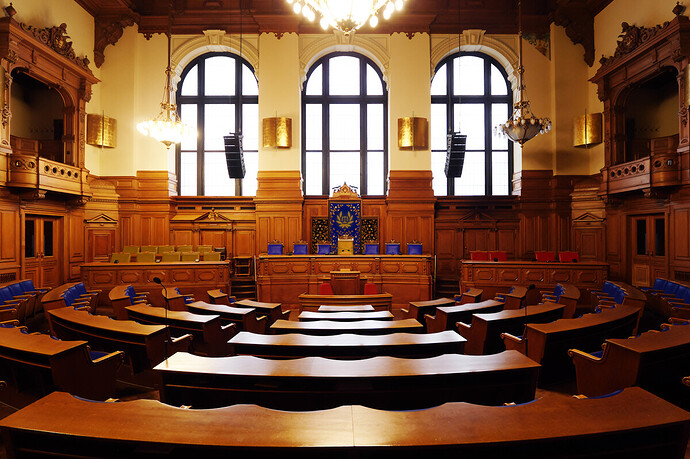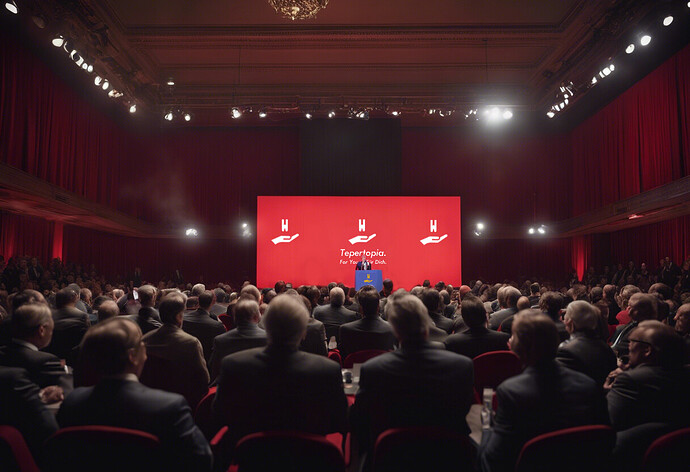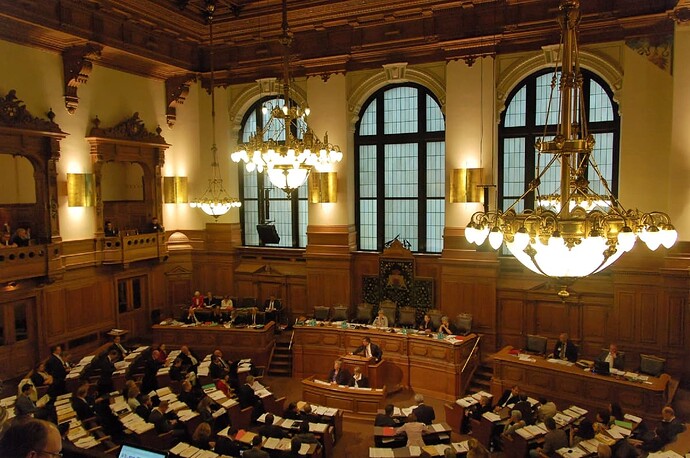
Electoral Reform Before The Assembly Tomorrow
Gudrun von Greifenstein · 20 October 2025
The Assembly in fierce debate during the bill’s second reading // OOC: Image © Ra Boe, CC BY-SA 3.0-de
ADACA — Eight months after being introduced, the bill to reform voting for the Tepertopian Assembly is expected to finally be passed by the Assembly. But not all are happy with the results of months of negotiations. Particularly, minor parties and some independents vehemently oppose a central change the bill aims to make.
Political Landscape Annoyed At Vote Counting Delays
In the 2024 Tepertopian Assembly election, the process of counting votes stretched for a whole nine days, longer than ever before. Under our Single Transferable Vote system, votes for unsuccessful candidates are continually redistributed to other candidates according to voter preference, until all seats up for election in the respective constituency have been won.
With a record number of candidates standing in that election, votes were being spread ever more thinly among ultimately unsuccessful candidates. Every time one of them was then eliminated from the race, all their current votes needed to be redistributed. Especially in the constituencies electing a greater number of seats, such as Adaca (10), Merpor (9), and Riverside (6), this necessitated exponentially more rounds of counting.
Future Elections To Be Streamlined
The current bill, named the Assembly Elections Acceleration Act (Bürgerschaftswahl-Beschleunigungsgesetz), is based on the recommendations of a cross-party committee formed by the Assembly directly after the election. If implemented, it would target both the high amount of seats up in some constituencies as well as the number of rounds of vote-counting.
Firstly, after an initial round of counting, all candidates receiving less than 15% of one “quota” of votes (that is, the number of votes to be guaranteed winning one of the seats in the constituency) would be eliminated all at once. This would remove the need to painstakingly redistribute votes from ultimately hopeless candidates to other, slightly less hopeless candidates one-by-one in the early rounds of counting.
Furthermore, the rigid requirement that administrative departments must not be subdivided into or between multiple constituencies would be abolished. Instead, a new cap of five seats per constituency would be introduced; if a constituency would be eligible for more than five according to the latest census, the constituency would have to be broken up into smaller ones. This elegantly ties into the existing statutory minimum of three seats per constituency.
Minor Parties In Uproar
.jpg) Assemblywoman Liza Buckley (R&Y) at today’s joint press conference // OOC: Image © Rosa Luxemburg-Stiftung, CC BY-SA 2.0
Assemblywoman Liza Buckley (R&Y) at today’s joint press conference // OOC: Image © Rosa Luxemburg-Stiftung, CC BY-SA 2.0
Particularly this last set of changes has caused much grief among minor parties and a few independents in the Assembly. An unlikely alliance of the Digital Democracy Party and The Grays, as well as the singular representative of The Republic & You! and independents von Rehm, Pfäffer, and McPatrick fear the reduced number of seats per constituency may effectively eliminate the chances of smaller contenders to attain representation in the federal legislature.
“With a statutory maximum of five seats per constituency, the quota for a seat would be 20% of votes, double of what it is in Adaca today. A group of voters with a strength below that number would not be able to secure a seat by themselves anymore and instead have to rely on vote transfers from others”, Assemblywoman Buckley (R&Y), herself elected to the 10th and final seat in Adaca, criticized at a joint press conference of the aforementioned earlier today. “It is a frontal assault on minority representation!”
Her colleague Assemblywoman Donnelly (GRAYS), similarly representing the 9th seat of Merpor, added: “Small parties play a vital role in our political system. Without a real possibility for outsiders to challenge the ideas of established parties, the people are ultimately locked into the spectrum of what a small circle of party leaders decides to offer them policy-wise.”
Speaking for the independents, Assemblyman von Rehm concludes: “Likewise, independent politicians have a long tradition in the Assembly. Without the concern of party loyalty, we have a unique freedom to represent the undiluted interests of our local communities.”
Concerns Just Fuelled By Egoism, Supporters Rebut
 Not convinced by the critics: Assemblyman Gustav Kawenz (Moderates) // OOC: Image © Olaf Kosinsky, CC BY-SA 3.0-de
Not convinced by the critics: Assemblyman Gustav Kawenz (Moderates) // OOC: Image © Olaf Kosinsky, CC BY-SA 3.0-de
The parties carrying the bill cannot understand these concerns. Talking to representatives of the Moderates, the Welfare Party, the Merchants’ Guild, and Canon, we found a surprisingly strong stance against further negotiations.
Assemblyman Kawenz (M), who represents the 1st seat of the Riverside constituency, explains: “For the better part of two years, we have extensively discussed this proposal with all political forces in the Assembly. We installed a special committee for preliminary negotiations, and then the bill was stuck in committee for eight months. We all agree that something needs to be done, but all the group around von Rehm has effectively done is say ‘but not this!’ – they block everyone’s ideas without coming up with something acceptable to others in return.”
When asked for their possible motives, Kawenz is certain: “They simply fear for their own seats, and subsequently purses. The current system helped them into a cozy, well-paid office, of course they don’t want this to change. In a normal constituency, some of them especially would never be elected.”
Assembly Decides Tomorrow
However rocky the path has been, whether naturally or artificially, tomorrow the Assembly will hold the bill’s 3rd reading and final vote on its passage. With a joint majority of 77 out of the 100 seats by the supporting coalition (M, W, GUILD, and C), the bill’s passage is virtually ensured. The Future is Ours! have announced not to whip this vote, allowing their eight Assemblypeople a free decision.
What will become of the bill after is not so sure, however - the opposing parties and independents have announced to pursue a referendum on the issue. With a joint strength of 12 votes, they are still three Assemblypeople short for invoking an uncodified legislative custom – 15 Assemblypeople may petition the Protector to consider calling a referendum by his own authority. Their main hope for this are of course FiO members, but independent Assemblywoman Erlenhauer, while more reserved, has also indicated interest in this possibility.
Should this option not be available to them, the opposing coalition would have to collect signatures from the electorate within a stringent timeframe – one hundred days for five percent of voters to sign the demand for a referendum. This might then also be their first indicator for how they’ll fare under the new bill.
Related media coverage:
- Rotkehlchen: Majority Rule or Tyranny of the Majority?!
- The Happelstein Herald: Centrist Majority on Final Stretch in Voting Reform Fight
- Die Zitronenpresse: SCANDAL: Proportional Voting System Elects Minority Representative









.jpg) Assemblywoman Liza Buckley (R&Y) at today’s joint press conference // OOC:
Assemblywoman Liza Buckley (R&Y) at today’s joint press conference // OOC:  Not convinced by the critics: Assemblyman Gustav Kawenz (Moderates) // OOC:
Not convinced by the critics: Assemblyman Gustav Kawenz (Moderates) // OOC: